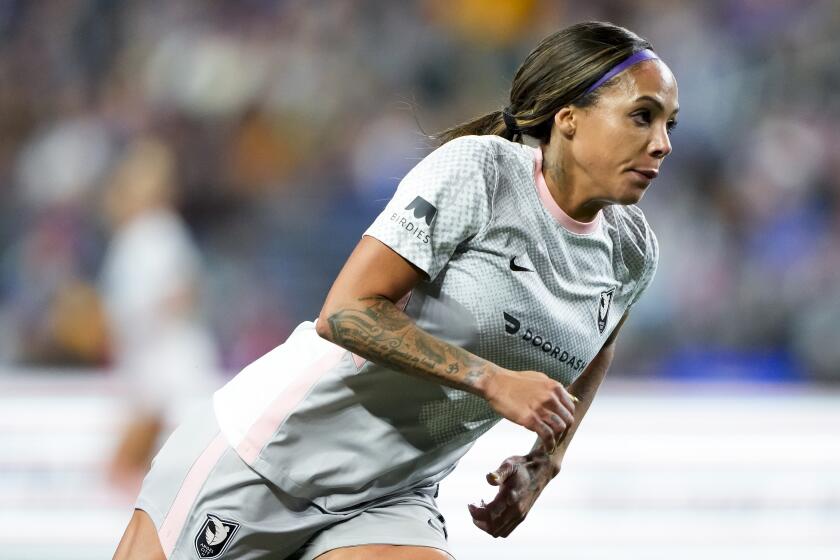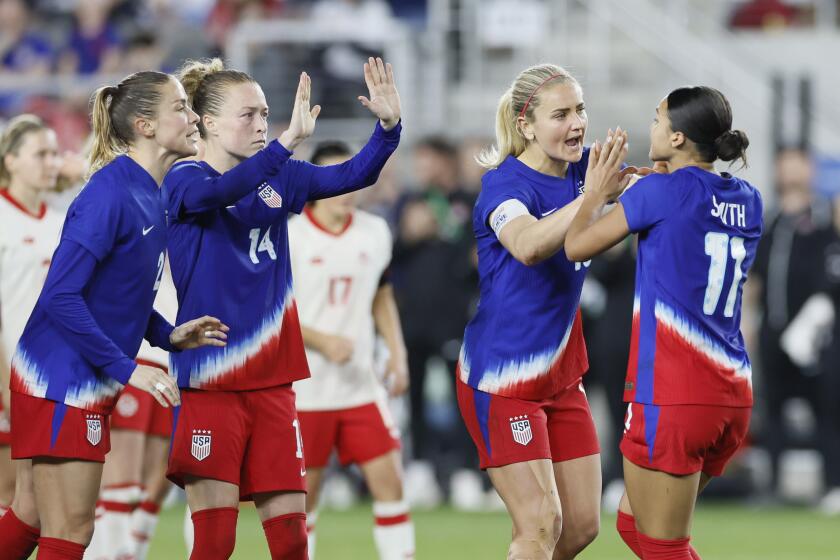Time to Move Beyond Their Cause’s Effects
The inaugural WUSA game, played in Washington, D.C., in 2001, drew 34,148. By the time the women’s professional soccer league folded this week, not many more people than that were watching on television.
Attendance had dropped nearly 20% in three seasons. And crowds and TV ratings have also been diminishing for the WNBA.
The failure this week of the WUSA, the professional women’s soccer league that spawned from the successful 1999 women’s World Cup, has staggered confidence in the future of women’s professional sports.
But it shouldn’t be a death knell, say several experts who say critics should have expected an evolution, not a revolution.
“In this country, men’s sports grew organically. Women’s sports grew legislatively,” said David Carter, head of the Sports Business Group and co-author of “On the Ball: What You Can Learn about Business from America’s Sports Leaders.”
What Carter means is that men’s sports, which now fill stadiums and arenas with thousands of people, which show up on television almost 24 hours a day, began modestly.
Games were invented because a few guys got together with bats and balls, hoops and goals, sticks and ice, and played. They formed teams, they got better. Their families started to come to the field to watch. Then friends and a few neighbors.
They played on schoolyards, in high school and college. Then more fans came and were willing to pay to watch. Arenas and stadiums were built. More fans came and paid more money. Radio and television were invented, and the fans were happy to watch the games from home.
With women, it took Title IX -- federal legislation that made it illegal for high schools and universities to treat men’s and women’s sports differently -- to make the sports grow.
“One of the problems associated with women’s professional athletics,” Carter said, “is that there is a cause associated with women’s sports. It’s the right thing to do, is the argument. And it’s an argument which has some merit; and at the high school and college level it’s more than an argument, it’s the law....
“A lot of women’s athletics, at least subtly, are positioned that way. But guess what? Corporate America doesn’t owe sports a nickel. Broadcast outlets don’t owe them a look-see. Fans aren’t obligated to spend their money. And that’s where the fork in the road has come. You can’t persuade or threaten, there is no ability to drop a legal hammer. As Yogi Berra might say, ‘If nobody’s going, you can’t stop them.’ ”
The failure of the WUSA prompted knowing head shakes and “I told you so” statements. To critics, the problem is clear: There is no domestic market for women’s professional sports.
Several experts disagree. They say there is room for women’s professional sports guided by investors with uncompromising patience, fabulous athletes willing to work for low wages, stellar marketing, creative genius, and money to buy television time.
Television time on channels where sports fans will find the games. On networks such as ESPN in any of its versions, Fox Sports, Fox Sports Net. Not PAX or Oxygen or other niche channels.
“If you have to buy television time on NBC or ESPN, do it,” said Leonard Armato, commissioner and reviver of the Assn. of Volleyball Professionals, a beach tour with men and women competitors.
Other expert advice:
* Forget the equality argument, Carter said. Pro sports isn’t college. Title IX is irrelevant. There is no law that says the WUSA is entitled to exist at all, much less as an equal to any other league. There is no law that says NBC must televise the WNBA or that ESPN must give time to the WUSA.
* Be realistic, said Jim Kahler, executive director of the MBA sports business program at Arizona State and former senior vice president of sales and marketing for the Cleveland Cavaliers of the NBA and Rockers of the WNBA.
He advises women’s sports professional leagues “to set their own benchmarks and come up with realistic timetables.”
“In Cleveland,” Kahler said, “I asked my female staff to help me figure out why we couldn’t get more season ticket holders for the Rockers. What they told me was: ‘Our lives are different than yours. Our time is less available. This isn’t like being a Browns’ season ticket holder. We can’t. Not at this point in our lives.’
“I had never thought of that, of the time commitment it takes to commit to purchasing season tickets. So you have to be creative with the women’s market. But it can be done.”
* Have a plan -- and stick to it -- said Sue Rodin, president of the New York-based Stars & Strategies Inc., a sports marketing and management agency.
Rodin, who represents seven players on the U.S. World Cup team, said of the WUSA hierarchy, “The people running the show had some challenges. They had the enthusiasm, but this was a business. Not to point fingers, but from what I understand the league went through nearly $100 million in three years.... Someone has to take responsibility for a budget.”
The eight-team WUSA had $40 million to start -- eight sponsors put in $5 million each. That money was supposed to last five years. At the end of the first year, league executives went back to the sponsors. The $40 million was gone.
“The financial losses were close to $60 million the first year,” said Dan Courtemanche, the WUSA’s vice president of communications and business development. “The losses were down to about $24 million in year two and between $17 million and $20 million in year three.” Courtemanche said that between the first and second years, the league’s office staff was cut from 35 to 17. In the first year, the WUSA employed two public relations agencies and an advertising agency. “People still remember the full-page ads in USA Today with Brandi Chastain and Mia Hamm,” Courtemanche said. “At the end of the first year, after the league went back to its sponsors for more money, the board of directors began meeting monthly. The way the league operated changed drastically.”
Tony Ponturo, vice president of global media and sports marketing for Anheuser-Busch Inc., said the WUSA or WNBA are no different from any new product.
“In any new situation, you have to find a reasonable level of expectation,” he said. “When you’re rolling out a new brand, you start slow. You test the market. You put the product in markets where it can make a dent.
“Pro sports tend to feel they have to have major markets for television. But one might wonder if, in the beginning, a league like women’s soccer should not have gone into Washington, D.C., New York, Philadelphia, markets where it had a tendency to get swallowed up.” If the measure of success is financial, Courtemanche said the Carolina Cougars, based in Cary, N.C., the smallest WUSA city, lost the least money. And the San Diego Spirit received the most media coverage.
Ponturo echoed Armato in extolling the value of being on the right television channel.
“How do sports fans handle the remote?” Ponturo said. “They surf through the 10 or 15 channels that always have sports. They go through the networks, through the ESPN channels, the Fox sports channels. Even if they don’t watch your game right now, they see a promo to watch the WUSA tomorrow at 11. You really need that in-your-face presence. On PAX, the WUSA became a little ‘out of sight, out of mind.’
“It does no good to tell a sponsor, ‘We’re on TV,’ if that TV station doesn’t deliver the goods.”
Good television exposure is no guarantee of success. The XFL, promoted endlessly on NBC, was a dramatic failure. But without good television, in this era, “I don’t think you can succeed,” Armato said.
Anheuser-Busch has invested in the WNBA, the LPGA and women’s soccer through the national team, Ponturo said. “If we help support women’s sports now, that support and loyalty will be returned by the female consumer down the road,” he said.
He sees potential with the LPGA, “not only because of Annika Sorenstam but also because of the good, young golfers coming up like Michelle Wie.”
But Ponturo, like Armato and Carter, said it will be more difficult for women’s team sports to succeed than it is in individual sports such as tennis, golf and figure skating.
“It seems, individually, somehow, women survive the comparisons made with men,” Ponturo said. “The differences are somehow softened in how you swing a club or make a putt. Same with tennis. It somewhat looks like the same game as the men. The team has a little tougher challenge. As fun and interesting as a WNBA game might be, the critic will say that it’s not the same caliber as the men.”
Carter predicted that if any league makes it for good, it will be the WNBA. “It has all the advantages,” he said. “It came on line as a brand extension of, arguably, the most popular league going. It had the NBA’s leverage for sponsorship contracts. It had great arenas. It had David Stern twisting some arms. And yet the WNBA is still not poised to succeed on its own.
“It’s a twofold problem. Right now new sports leagues are facing a tough economic climate, no matter the gender issue. And, too often, expectations are off the charts. The expectations are so high, they will never be met.
“As soon as the question gets asked as to when the WNBA will draw the same ratings as the NBA, it’s the same as answering the question, ‘So when did you stop beating your wife?’ Once the question is asked, you’ve lost.
“There is nothing wrong with being a secondary league, and maybe there needs to be that acceptance for women’s pro leagues right now.”






